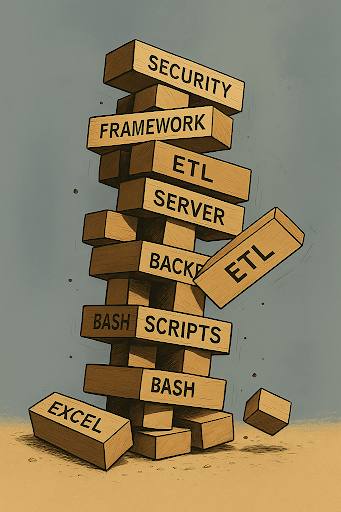By David Bell
In a previous post, we argued that the primary obstacle to AI adoption isn’t technology, it’s people. The friction lies in culture, mindset, and trust. But if the challenge is human, the solution begins with the environment we ask them to work in. It starts by building a better foundation.

Imagine trying to build a Skyscraper on quicksand, you would expect a lot of wasted effort, frustration, and inevitably failure. The same holds true for AI. Your culture might be all-in on experimentation, your exec team eager, your data scientists full of caffeine and bravado, and yet projects still fizzle out. Why? Because the foundation is patchy: one tool for pipelines, another for dashboards, half a dozen “temporary” scripts that somehow turned permanent, and a graveyard of forgotten notebooks.
When the Tech Stack Looks Like Jenga
Tool sprawl is the polite term. Most teams know it as business as usual.
- Data silos multiply. Sales logs sit in the CRM, sensor readings lounge in a S3 bucket no one has access to, while finance maintains its own Excel kingdom.
- Workflows drift. A model built in one tool ends up re-written in another because nobody could access/maintain/understand it.
- People burn out. Engineers plug leaks; analysts wait for refresh windows; security teams wave red flags no one has time to read.

It’s not just slow, it’s demoralizing. Teams spend hours hunting for the “latest” dataset, only to discover three mutually exclusive versions. Momentum stalls, trust erodes, and budgets sneak off to shinier initiatives.
The question that keeps many a CTO up at night is how do I bring all these tools together? How do we enable our teams to move fast, experiment, and actually push real insights that drive change?
The answer is a Unified Intelligence Platform.
What Is a Unified Intelligence Platform?
Think of a Unified Intelligence Platform as the concrete slab beneath the skyscraper, not another flashy facade bolted on later. This is the base from which you can build your AI strategy on, a place that brings together your data, analytics and AI to provide a single source of truth.
- Consolidated operations. Data ingestion, lineage, orchestration, and observability live in one pane of glass.
- Intelligent automation. Tasks that scream “grunt work” – deployment, integration, containerisation, resource scaling – handle themselves.
- Intuitive interfaces. Analysts, Python lovers, business users: each sees the same truth in the interface they prefer.
deckchair’s multi-agent platform slots neatly into this model. It brings all your operations into one place, automates the tasks that slow your teams down and limit your ability to move from prototypes to production, and provides the interfaces that supports transformative data driven decision making across your business.
Five Ways a Unified Intelligence Platform Turns Grind Into Glide
a) It Shrinks Complexity
Have you ever watched a junior engineer’s face when you explain the home-grown airflow-plus-Bash-plus-cron special? It’s a mix of awe and dread. A Unified Intelligence Platform collapses that labyrinth into clear, guided workflows. Suddenly, people with domain expertise -not just ModelOps guys- can actually ship value.
b) It Speeds Up the Loop
The faster you can move from idea → prototype → feedback→ better prototype, the faster you learn. With a unified layer, scripts used to create features or clean data need only be created once and feed both the training run and the live model. No waiting on cross-team developers or hand offs. Momentum, restored.
c) It Flexes With You
Start narrow: a simple use case that tackles a single, but important problem. When leadership gets excited and asks to expand it to new customers or add new features, the same platform extends – new data sources plug in, new processes drop into the workflow, pipelines expand. No six-month refactor, just steady growth.
d) It Frees Humans for Real Thinking
Automate data quality checks or email reports. Auto-generate API endpoints that spare developers the boilerplate. Integrate new data sources with just a few clicks. That leaves people to ponder the tougher questions: which model assumption is shaky, which KPI signals a real market shift, which experiment needs a different metric? Strategy over slog.
e) It Builds Trust, Quietly
Consistency is charisma’s quieter cousin. When dashboards agree with reports, when access policies echo across services, when nightly jobs actually finish nightly, belief spreads. Stakeholders stop hedging and start planning with confidence.
Choosing the Right Foundation for Change
A Unified Intelligence Platform isn’t a fancy add-on. It’s the bedrock that lets culture, strategy, and talent do their best work. Pick one that:
- speaks your language, whether that’s Python notebooks, R, SQL or all of the above;
- plays well with your existing stack (nothing wrong with keeping Snowflake or Postgres if they pull their weight);
- and, crucially, makes it easy to start small.

Because the biggest secret in AI success isn’t a secret at all: small wins, shipped often, build the muscle for big wins later. A Unified Intelligence Platform keeps those reps safe, coordinated, and repeatable.
So next time someone suggests “just one more tool” to plug a gap, pause. Ask whether you’re adding another wobbly Jenga block or laying fresh concrete beneath the whole tower. Choose the foundation that invites progress rather than patches over chaos. Your future data team, less frazzled and more curious, will thank you.

